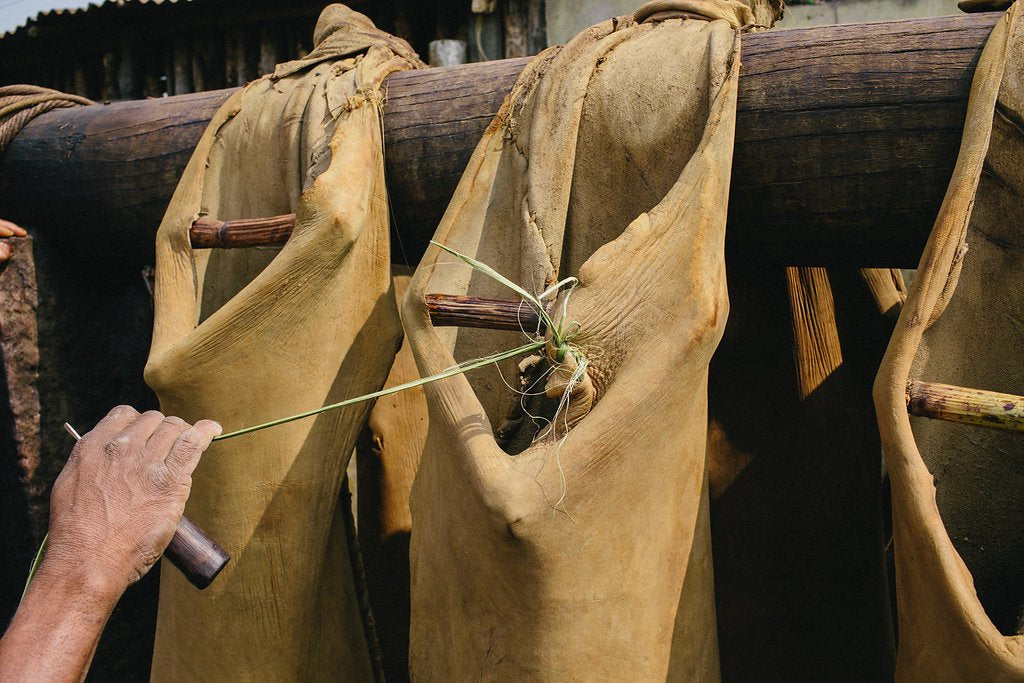
For as long as the shoemakers who work with us can remember, their families have worked with water buffalo leather. This leather is purchased from family tanners who live and work about an hour from Athani Village. They tan leather in a slow, hands-on, non-mechanized way, in a trade that’s been passed down through generations. It’s closer to the way leather was made for thousands of years, until the process was industrialized.

With each material used to make and sell Mohinders, we do our best to reduce waste, avoid synthetics and limit our environmental impact. For us, a primary way to reduce our impact is through heirloom, non-industrialized materials and processes.
Traditional methods often don’t qualify for international certifications like Fair Trade and Certified Organic, yet we believe they inherently operate at an appropriate, small scale—and work in healthier balance with their surrounding ecosystem than modern industrialized practices.
We also think leather is one best materials in the world—it’s been made by humans for thousands of years. Vegetable-tanned leather (including traditionally-tanned leather, like ours) only gets better with time.

We made the trip to meet with a group of leather-producing families. They live and work in a tiny village surrounded by turmeric and sugarcane fields, about an hour from Athani, where Mohinders are made.
This old way of producing leather, called bag-tanning, uses a solution comprised of just three ingredients: water, acacia tree bark, and crushed myrobalan nut (myrobalan is also used as a natural dye and as a natural remedy).

Water buffalo hides are stitched into bags using plant fibers, then the three-ingredient tanning solution is poured into each bag; it slowly seeps out for a few days. Then the bags are flipped and filled again, for the process to repeat and even out top and bottom. In this way, the tanning solution fully saturates all the layers of each hide.
Aside from a simple machine that crushes myrobalan nuts into a powder, every step is done by hand; this marks the key difference between Mohinders leather and any leather (veg-tanned or not), made in a modern tannery.
How is other leather made?
Raw hides are turned into leather in a process called tanning, or treating raw animal skin to modify its proteins and stop it from degrading as it normally would. Tanning turns a raw hide into leather.
For most of history, tanning was basically done the same way: soaking hides in a solution of vegetable tannins (like oak bark) for many weeks, so the liquid saturates the hide and alters the proteins. This is called vegetable tanning or veg-tanned leather.
In 1858, the industrialized world invented chrome tanning. Chromium can replace plant-based tanning agents for a faster, cheaper, and more chemical-intensive process. Hides are treated with acidic salts, then chromium alters the skin’s structure, turning it to leather. The whole process can be finished in a day, and creates super-soft leather that can be made a rainbow of bright colors. About 90% of today’s leather is made in this way.
 image by Pete McBride for National Geographic
image by Pete McBride for National Geographic
Why does bag-tanned leather matter?
Quality Bag-tanning creates strong, durable leather that patinas beautifully, and helps support the work of family tanneries.
Environmental impact From what we saw and heard on our visit, this method also has a lower environmental impact than its industrial counterparts.
Regionality Mohinders shoes are inseparable from this type of leather. The shoe designs in this region evolved to with this particular material, so our shoes wouldn’t be the same product without it.

We don't have all the answers
Even after our trek to the micro-tannery, there are still some unanswered questions about this part of our supply chain. We haven't chemically analyzed the tanning agents and waste water for safety data. We have only have only anecdotal evidence about where the water buffalo are raised, and whether they die of natural causes after a life as a dairy or agricultural work animal. We hope to learn if and how they’re slaughtered, if they’re slaughtered for their hides alone, and whether the hides are a co- or by-product of meat harvesting; and if so, where the meat is distributed (those are questions for our next trip).
While this way of making leather is remarkably different from other methods we know of (in India or anywhere else), we share all this because we know we don’t have perfect answers about our impact. We're compelled to keep learning about better, less harmful ways of producing leather, and desire above all to be transparent about our practices. As people who are interested in digging into complexity we truly appreciate your thoughtful questions.
